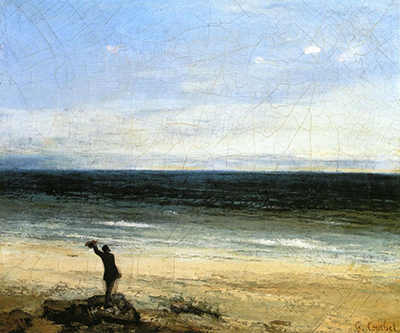The Seaside at Palavas continues Courbet's work with seascapes, choosing this time to include a single figure in the foreground which helps provide an element of perspective.
Most of Courbet's other seascapes would remove all involvement of humanity, other than perhaps a small fishing vessel left idly on the shore. Perhaps he felt the piece would have been too bereft of detail or interest without this figure. There are no cliffs, for example, but we can make out land across the water in the distance. Perhaps the figure is waving at that region. The beach is bright as usual for this artist, but he chose to use a darker blue for the sea on this occasion. Small spots of white paint help to create the ripples of the sea, though the waves do not appear to be too aggressive.
The use of individuals in the foreground of a sprawling landscape scene can be seen most frequently in the work of German Romanticist painter, Caspar David Friedrich. He did not do many seascapes such as this, though, and preferred to put his figures in front of sprawling mountains, where the terrain was much hillier and varied. Courbet produced work in batches, from similar locations as he travelled around France. He would later also work in Switzerland and Germany too. He was forced to leave France in the end to avoid a huge fine for political meddling, an amount so large that he had no realistic way of paying it and was therefore forced to flee over the border.
The Seaside at Palavas was completed by the artist in 1854 on the beach at beach at Palavas-les-Flots. The original artwork can now be found in the Musée Fabre in Montpellier and several elements of research have suggested that it was directly inspired by Friedwich's The Monk by the Sea. The similarities certainly cannot be denied. The Musée Fabre, Montpellier holds a selection of work by Courbet, much of which made it into it's collection through a number of generous donations.




